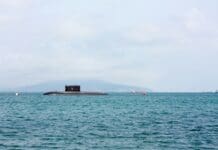This post is also available in:
 עברית (Hebrew)
עברית (Hebrew)
Lockheed Martin’s Patriot PAC-3 MSE interceptor was successfully fired using Lockheed’s virtualized Aegis weapon system and took down a live target simulating a cruise missile. The fully virtualized combat system can reportedly run on any server and be updated in hours.
This test marks the first time the PAC-3 MSE has been launched in this configuration (utilizing the virtualized Aegis weapon system to intercept a live target) and offers an additional air and missile defense option for the US armed forces.
Lockheed Martin reported that it conducted the test in partnership with many services in the Department of Defense. Tom Copeman, vice president of Strategy and Naval Programs at Lockheed Martin, stated: “This successful test showcases Lockheed Martin’s commitment to developing mission-focused, integrated technology to keep those who serve ahead of evolving threats. These systems could deliver a proven, Integrated Air and Missile Defense (IAMD) capability with growing capacity to the US to help defend against advanced, maneuverable threats.”
The company also declared that it is working to deliver enhanced IAMD capability to the country’s most modern combat system to defend against simultaneous advanced air, surface, and missile threats.
According to Interesting Engineering, the PAC-3 missiles are meant to defend against incoming threats (tactical ballistic missiles, cruise missiles, and aircraft) through direct body-to-body contact, delivering much more kinetic energy on the target than can be achieved with blast-fragmentation kill mechanisms.
The PAC-3 MSE reportedly has a two-pulse solid rocket motor providing increased performance in altitude and range, boasts a highly accurate seeker, high data processing rate, and top-notch simulation and testing.
The missile is designed to use the initial cues to fly to a designated point where the intended target is projected, yet it can also receive guidance updates using datalink mid-course. For the final leg of the journey, and to be as accurate as possible, the missile switches to its active radar seeker. It can reach a maximum altitude of 35,966 meters and a target range of 120 kilometers.


























